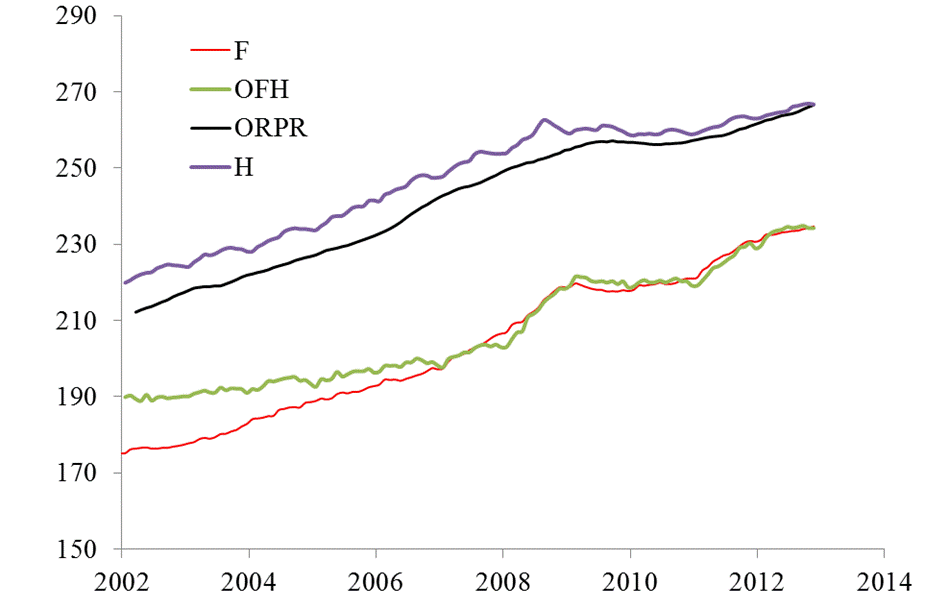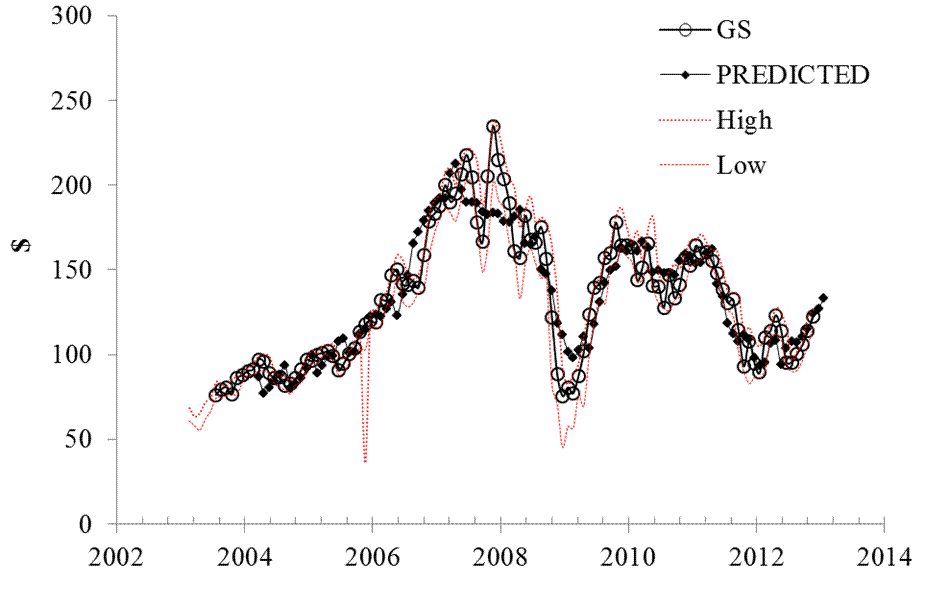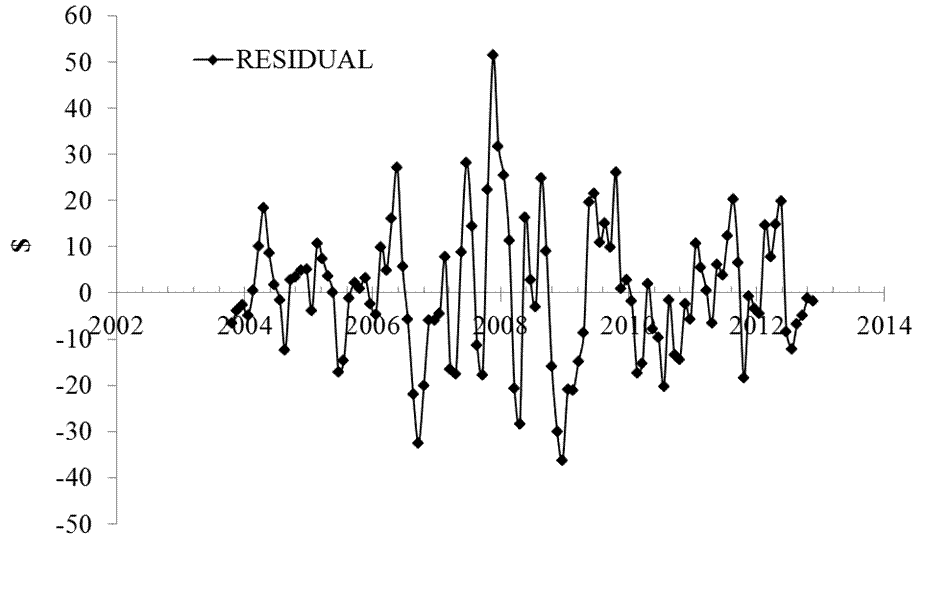We have been trying to build a preliminary pricing model for Goldman Sachs (GS) since 2008. This company was included in our study of bankruptcy cases in the USA. All in all, the model was not stable over time and the prediction for 2009 was not fully correct.
Originally, the stock price was defined by the index of housing operations (HO) and that of food away from home (SEFV). In January 2011, we presented an updated model as based on the CPIs available till November 2010 and the December monthly closing (adjusted for splits and dividends) price of GS. In the updated model, the defining CPIs are the index of other food at home (OFH) and the housing index (H). Thus, the difference between the preliminary and the updated model was not too large because the pairs of defining indices are very close. Here we present a revised model, which includes new data obtained since December 2010. The revised model shows that GS share may grow to $133 from its current level of $118. This might be a good long idea together with that for Prudential Financial (PRU).
The concept of share pricing based on the link between consumer and stock prices has been under development since 2008. In the very beginning, we found a statistically reliable relationship between ConocoPhillips’ (COP) stock price and the difference between the core and headline consumer price index (CPI) in the United States. Then we extended the pool of defining CPIs to 92 and estimated quantitative models for all companies from the S&P 500. The extended model described the evolution of a share price as a weighted sum of two individual consumer price indices selected from this large set of CPIs. We allow only two defining CPIs, which may lead the modeled share price or lag behind it. The intuition behind the lags is that some companies are price setters and some are price takers. The former should influence the relevant CPIs, which include goods and services these companies produce. The latter lag behind the prices of goods and services they are associated with. In order to calibrate the model relative to the starting levels of the involved indices and to compensate sustainable time trends (some indices are subject to secular rise or fall) we introduced a linear time trend and constant term. In its general form, the pricing model is as follows:
sp(tj) = Σbi∙CPIi(tj-ti) + c∙(tj-2000 ) + d + ej (1)
where sp(tj) is the share price at discrete (calendar) times tj, j=1,…,J; CPIi(tj-ti) is the i-th component of the CPI with the time lag ti, i=1,..,I (I=2 in all our models); bi, c and d are empirical coefficients of the linear and constant term; ej is the residual error, whose statistical properties have to be scrutinized.
By definition, the bets-fit model minimizes the RMS residual error. It is a fundamental feature of the model that the lags may be both negative and positive. In this study, we limit the largest lag to eleven months. System (1) contains J equations for I+2 coefficients. We start our model in July 2003 and the share price time series has more than 100 points. To resolve the system, standard methods of matrix inversion are used. A model is considered as a reliable one when the defining CPIs are the same during the previous eight months. This number and the diversity of CPI subcategories are both crucial parameter. For example, Table 1 lists defining parameters for GS between March and October 2012. For each month, the best model is based on the same defining CPIs – the consumer price index of food and beverages, F, and the index of owners’ rent of primary residence, ORPR. In all cases, the lags are the same: three and two months, respectively. Other coefficients and the standard error suffer just slight oscillations or drifts (e.g. c and d). It is important to stress again that all models for months except October also include those with future CPIs relative to the given month. Table 1 confirms that no future CPIs drive the share price in March 2012. The best fir model is always based on the past values of F and ORPR, at least since March 2012.
Figure 1 depicts the overall evolution of both involved consumer price indices: F and ORPR. It also presents the evolution of two defining indices from the previous model: the index of other food at home, OHF, which is a part of F, and the index of housing, H, with ORPR representing a part of H. The OHF and H indices provided the best fit model between March 2010 and December 2010. The best-fit models for GS(t) are as follows:
GS(t) = -11.06OFH(t) +11.06H(t-12) - 1.82(t-2000) – 99.4, December 2010
GS(t) = -13.79F(t-3) +11.03ORPR(t-2) + 29.93(t-2000) + 33.75, October 2012
The predicted curve in Figure 2 leads the observed price by two months. The residual error is of $14.52 for the period between July 2003 and October 2012. The price of a GS share is relatively well defined by the behaviour of the two defining CPI components. Figure 2 also depicts the high and low monthly prices for the same period, which illustrate the intermonth variation of the share price. These prices might be considered as natural limits of the monthly price uncertainty associated with the quantitative model. Since 2009, the predicted price is well within the high/low band. Figure 3 displays the residual error.
Table 1. The evolution of GS model since March 2012



- English (UK)
- English (India)
- English (Canada)
- English (Australia)
- English (South Africa)
- English (Philippines)
- English (Nigeria)
- Deutsch
- Español (España)
- Español (México)
- Français
- Italiano
- Nederlands
- Português (Portugal)
- Polski
- Português (Brasil)
- Русский
- Türkçe
- العربية
- Ελληνικά
- Svenska
- Suomi
- עברית
- 日本語
- 한국어
- 简体中文
- 繁體中文
- Bahasa Indonesia
- Bahasa Melayu
- ไทย
- Tiếng Việt
- हिंदी
Goldman Sachs May Rise To $133 In January 2013
Published 11/25/2012, 03:51 AM
Updated 07/09/2023, 06:31 AM
Goldman Sachs May Rise To $133 In January 2013
3rd party Ad. Not an offer or recommendation by Investing.com. See disclosure here or
remove ads
.
Latest comments
Install Our App
Risk Disclosure: Trading in financial instruments and/or cryptocurrencies involves high risks including the risk of losing some, or all, of your investment amount, and may not be suitable for all investors. Prices of cryptocurrencies are extremely volatile and may be affected by external factors such as financial, regulatory or political events. Trading on margin increases the financial risks.
Before deciding to trade in financial instrument or cryptocurrencies you should be fully informed of the risks and costs associated with trading the financial markets, carefully consider your investment objectives, level of experience, and risk appetite, and seek professional advice where needed.
Fusion Media would like to remind you that the data contained in this website is not necessarily real-time nor accurate. The data and prices on the website are not necessarily provided by any market or exchange, but may be provided by market makers, and so prices may not be accurate and may differ from the actual price at any given market, meaning prices are indicative and not appropriate for trading purposes. Fusion Media and any provider of the data contained in this website will not accept liability for any loss or damage as a result of your trading, or your reliance on the information contained within this website.
It is prohibited to use, store, reproduce, display, modify, transmit or distribute the data contained in this website without the explicit prior written permission of Fusion Media and/or the data provider. All intellectual property rights are reserved by the providers and/or the exchange providing the data contained in this website.
Fusion Media may be compensated by the advertisers that appear on the website, based on your interaction with the advertisements or advertisers.
Before deciding to trade in financial instrument or cryptocurrencies you should be fully informed of the risks and costs associated with trading the financial markets, carefully consider your investment objectives, level of experience, and risk appetite, and seek professional advice where needed.
Fusion Media would like to remind you that the data contained in this website is not necessarily real-time nor accurate. The data and prices on the website are not necessarily provided by any market or exchange, but may be provided by market makers, and so prices may not be accurate and may differ from the actual price at any given market, meaning prices are indicative and not appropriate for trading purposes. Fusion Media and any provider of the data contained in this website will not accept liability for any loss or damage as a result of your trading, or your reliance on the information contained within this website.
It is prohibited to use, store, reproduce, display, modify, transmit or distribute the data contained in this website without the explicit prior written permission of Fusion Media and/or the data provider. All intellectual property rights are reserved by the providers and/or the exchange providing the data contained in this website.
Fusion Media may be compensated by the advertisers that appear on the website, based on your interaction with the advertisements or advertisers.
© 2007-2024 - Fusion Media Limited. All Rights Reserved.
